
Testking_640-802_V13
.pdf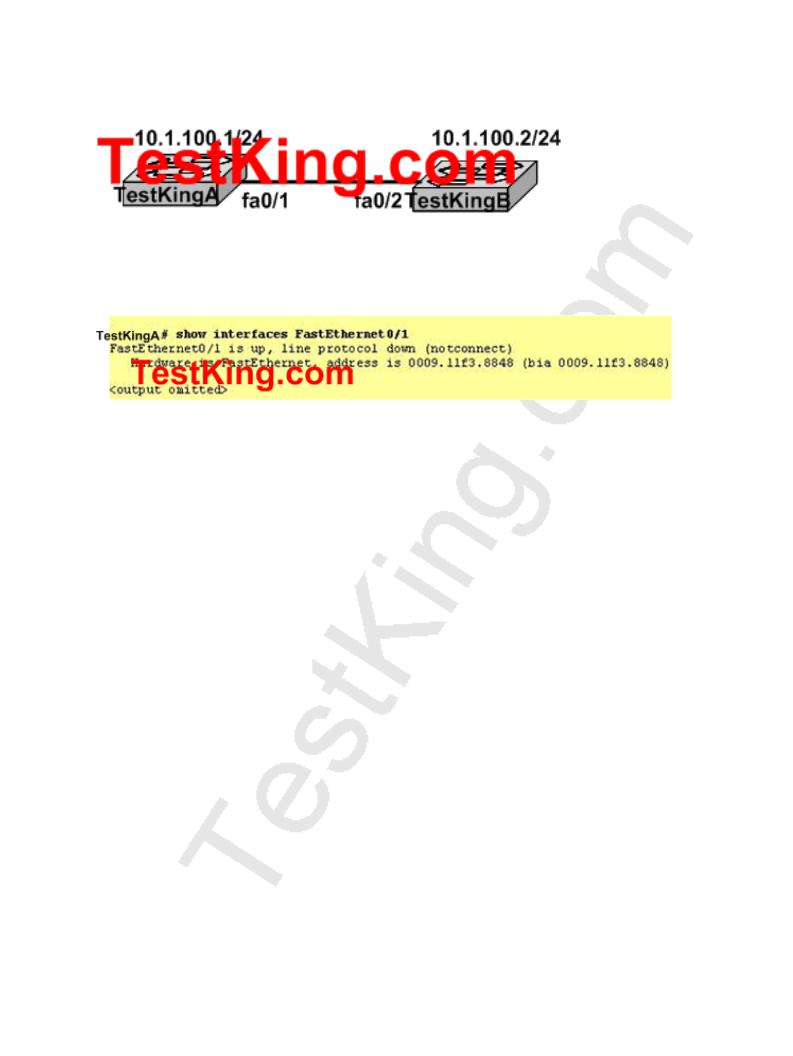
The interface status of TestKing A is shown below:
The TestKing network administrator has verified that a functioning cable connects Switch TestKing1 and Switch TestKing2 shown above. From the output that is shown above, what two pieces of information below are true? (Choose two)
A.Using a source MAC address of 0009.11f3.8848, Switch TestKing2 is sending frames to Switch TestKing1
B.The status of fa0/2 should be checked on Switch TestKing2
C.The interface is functional at OSI layer 1
D.There is likely to be an IP address issue on Switch TestKing1 Fa0/1
E.Interface fa0/1 on Switch TestKing1 is in a shutdown state
F.Switch TestKingB is not powered on
Answer: B, C
QUESTION NO: 5
Two TestKing routers are connected as shown below:
Leading the way in IT testing and certification tools, www.testking.com
- 141 -
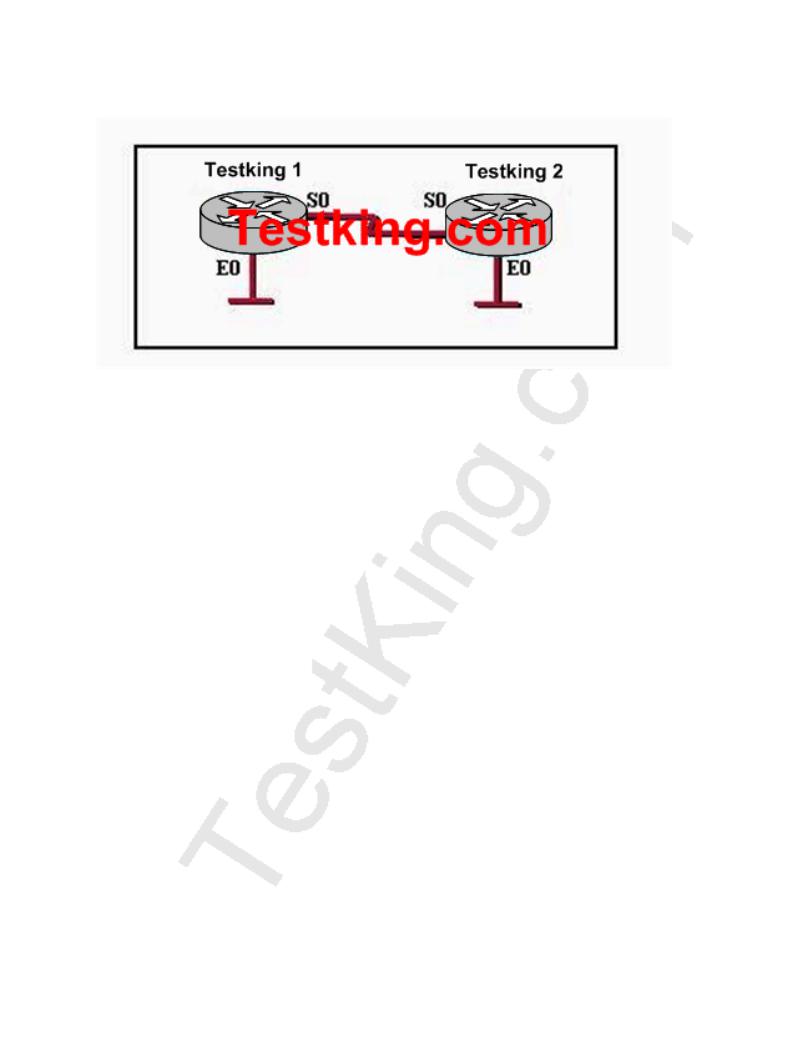
After configuring the routers shown in the graphic, the technician decides to test and document the network. Pings from the technician's laptop to all of the interfaces on each router were successful. If a technician initiates a Telnet session to Testking 1 and issues the "show arp" command, which of the following items will be among the entries displayed in the output?
A.The MAC address of the S0 interface on Testking 1
B.The MAC address of the E0 interface on Testking 1
C.The MAC address of the S0 interface on Testking 2
D.The MAC address of the E0 interface on Testking 2
E.None of the above
Answer: B Explanation:
To display the Address Resolution Protocol (ARP) cache, enter the show arp command in EXEC mode. ARP establishes correspondences between network addresses (an IP address, for example) and Ethernet hardware addresses. A record of each correspondence is kept in a cache for a predetermined amount of time and then discarded. Serial interfaces will not appear, only the local Ethernet interfaces on the router.
QUESTION NO: 6
Leading the way in IT testing and certification tools, www.testking.com
- 142 -

You are the administrator of the TestKing LAN and you have been reviewing error logs of networking devices and notice a large number of errors associated with several MAC addresses. You suspect that some of the errors are being generated by the routers. Which router commands will allow you to find the ip address associated with each MAC address? (Choose two)
A.show arp
B.show version
C.show address
D.show hosts
E.show interface
F.show protocols
Answer: A, E
Explanation:
The "show arp" command Displays the entries in the ARP table, including their layer 2 MAC address and layer 3 IP address.
Example:
The following is the output for the show arp command on Router 1:
TK1 # show arp
Protocol Address Age (min) Hardware Addr Type Interface
Internet 10.0.0.3 0 0004.dd0c.ffcb ARPA Ethernet01
Internet 10.0.0.1 - 0004.dd0c.ff86 ARPA Ethernet0
To see the MAC (hardware) address of the router interfaces as well as their IP addresses, use the "show interfaces" command as shown in the example below:
TK1# show interfaces
Ethernet 0 is up, line protocol is up
Hardware is MCI Ethernet, address is 0000.0c00.750c (bia 0000.0c00.750c) Internet address is 10.108.28.8, subnet mask is 255.255.255.0
MTU 1500 bytes, BW 10000 Kbit, DLY 100000 usec, rely 255/255, load 1/255
QUESTION NO: 7
Leading the way in IT testing and certification tools, www.testking.com
- 143 -

The TestKing network administrator issues the ping 192.168.2.5 command and successfully tests connectivity to a host that has been newly connected to the network. Which protocols were used during the test? (Choose two)
A.ARP
B.CDP
C.DHCP
D.DNS
E.ICMP
Answer: A, E
Explanation:
ARP finds the hardware address of a host from a known IP address. Here's how it works: when IP has a datagram to send, it must inform a Network Access protocol, such as Ethernet or Token Ring, of the destination's hardware address on the local network. (It has already been informed by upper-layer protocols of the destination's IP address.) If IP doesn't find the destination host's hardware address in the ARP cache, it uses ARP to find this information.
ICMP works at the Network layer and is used by IP for many different services. ICMP is a management protocol and messaging service provider for IP. Its messages are carried as IP datagrams. RFC 1256 is an annex to ICMP, which affords hosts' extended capability in discovering routes to gateways. Periodically, router advertisements are announced over the network, reporting IP addresses for the router's network interfaces. Hosts listen for these network infomercials to acquire route information. A router solicitation is a request for immediate advertisements and may be sent by a host when it starts up.
QUESTION NO: 8
Refer to the TestKing network segment shown below:
Leading the way in IT testing and certification tools, www.testking.com
- 144 -
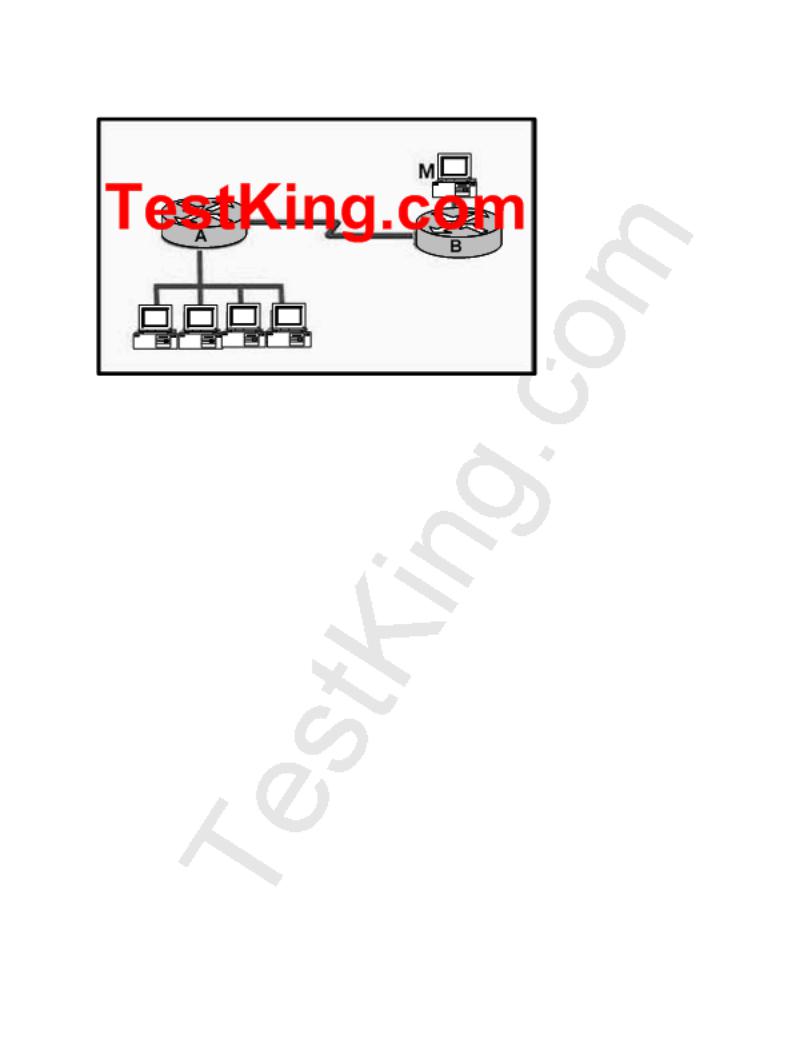
In this network, The TestKing manager on workstation M uses Telnet to log in to the command line interface of router A. The administrator wishes to discover information about active workstations on the LAN attached to router A, including their IP and MAC addresses. Which command will provide this information?
A.show running-config
B.show hosts
C.show ip arp
D.show cdp neighbors
E.show interfaces
F.None of the above
Answer: C Explanation:
ARP establishes correspondences between network addresses (an IP address, for example) and LAN hardware addresses (Ethernet addresses). A record of each correspondence is kept in a cache for a predetermined amount of time and then discarded. The following is sample output from the show ip arp command:
TK1# show ip arp
Protocol Address Age(min) Hardware Addr Type Interface
Internet 172.16.233.22 9 0000.0c59.f892 ARPA Ethernet0/0
Internet 172.16.233.21 8 0000.0c07.ac00 ARPA Ethernet0/0
Internet 172.16.233.19 - 0000.0c63.1300 ARPA Ethernet0/0
Internet 172.16.233.30 9 0000.0c36.6965 ARPA Ethernet0/0
Leading the way in IT testing and certification tools, www.testking.com
- 145 -

Reference: http://www.cisco.com/en/US/products/sw/iosswrel/ps5187/products_command_reference_chapter09186a008
Section 7: Identify, prescribe, and resolve common switched network media issues, configuration issues, auto negotiation, and switch hardware failures (6 questions)
QUESTION NO: 1
While troubleshooting an issue in the TestKing LAN you notice that a network interface port has collision detection and carrier sensing enabled on a shared twisted pair network. From this statement, what is known about the network interface port?
A.This is an Ethernet port operating at half duplex
B.This is an Ethernet port operating at full duplex
C.This is a port on a network interface card in a PC
D.This is 10 MB/s switch port
E.This is a 100 MB/s switch port
F.None of the above
Answer: A
QUESTION NO: 2
When a switch port is used as a VLAN trunk, which of the following trunk modes are valid? (Select all that apply.)
A.Blocking
B.Auto
C.Desirable
D.On
Leading the way in IT testing and certification tools, www.testking.com
- 146 -
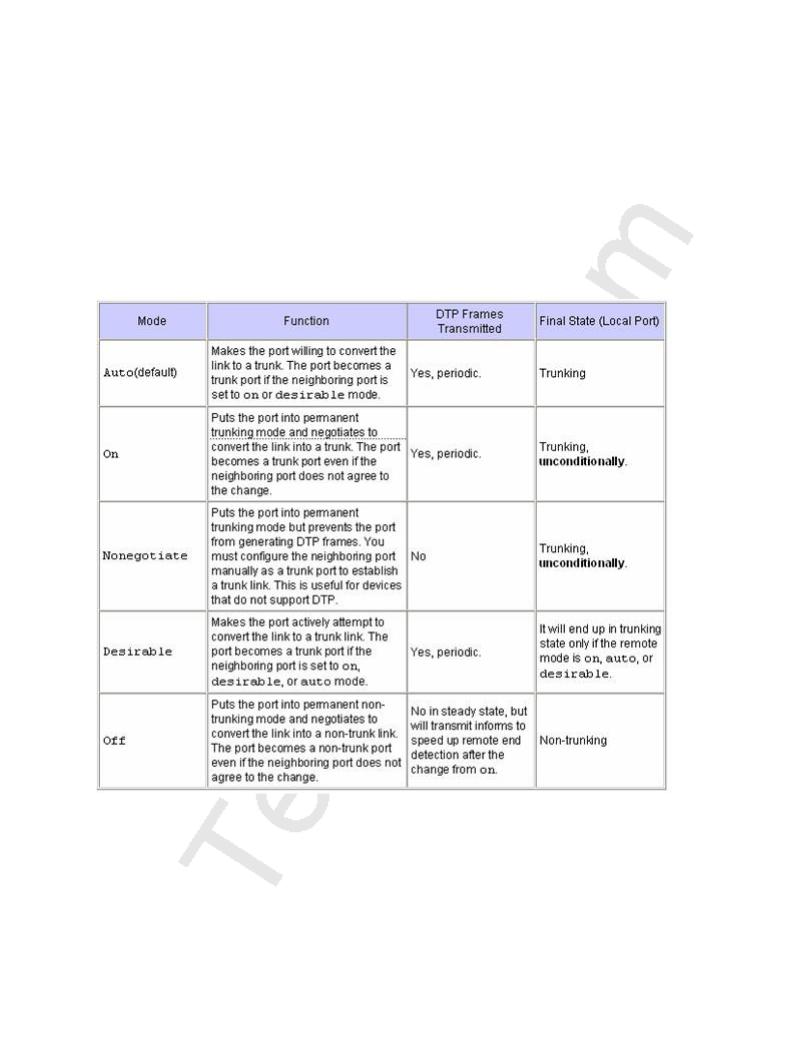
E.Transparent
F.Learning
Answer: B, C, D Explanation:
A trunk port can be configured as one of the following 5 different modes: on, off, desirable, auto, or nonegotiate.
The table below is a summary of the configuration modes.
Leading the way in IT testing and certification tools, www.testking.com
- 147 -

QUESTION NO: 3
Which of following VLAN frame encapsulation types are configurable on a Cisco switch? (Select two answer choices.)
A.VTP
B.802.1Q
C.LLC
D.ISL
E.CDP
F.PAP
Answer: B, D
Explanation:
ISL and 802.1Q are the two trunking encapsulations that can be configured on a Cisco switch. ISL is Cisco proprietary and 802.1Q is the IEEE standard method.
Incorrect Answers:
A. VTP is the VLAN Trunking Protocol, which is used to carry VLAN information across the trunks. The question is asking for the encapsulation options for the trunk, which will be used by VTP.
C. LLC is the Logical Link Control, which is a sub-layer of the data link layer.
E.CDP is the Cisco Discovery Protocol, which is used by Cisco devices to discover information on neighboring Cisco devices.
F.PAP is the Password Authentication Protocol, which is used as an authentication mechanism on PPP links.
QUESTION NO: 4
TestKing users have noticed extremely slow network performance, intermittent connectivity, and connection losses. After entering the "show interfaces" command, you notice that the Ethernet interface is configured as 100 Mbps full-duplex and that there is evidence of late collisions. What could be the cause of this problem?
A.Duplex mismatch
B.A routing loop
C.Trunking mode mismatch
Leading the way in IT testing and certification tools, www.testking.com
- 148 -

D.Improperly configured root bridge
E.Improperly configured static VLAN
F.None of the above
Answer: A Explanation:
A duplex mismatch may result in performance issues, intermittent connectivity, and loss of communication. When troubleshooting NIC issues, verify that the NIC and switch are using a valid configuration. Some third-party NIC cards may fall back to half-duplex operation mode, even though both the switchport and NIC configuration have been manually configured for 100 Mbps, full-duplex. This behavior is due to the fact that NIC autonegotiation link detection is still operating when the NIC has been manually configured. This causes duplex inconsistency between the switchport and the NIC. Symptoms include poor port performance and frame check sequence (FCS) errors that increment on the switchport. To troubleshoot this issue, try manually configuring the switchport to 100 Mbps, half-duplex. If this action resolves the connectivity problems,you may be running into this NIC issue. Try updating to the latest drivers for your NIC, or contact your NIC card vendor for additional support.
Reference: http://www.cisco.com/en/US/products/hw/switches/ps700/products_tech_note09186a00800a7af0.shtml
QUESTION NO: 5
You are experiencing intermittent issues relating to congestion within the TestKing network. What are the possible causes of congestion on this LAN? (Choose all that apply)
A.A broadcast domain with too many hosts.
B.Full duplex operation.
C.Broadcast storms.
D.Multicasting.
E.Network Segmentation.
F.Low bandwidth.
Answer: A, C, F
Explanation:
Leading the way in IT testing and certification tools, www.testking.com
- 149 -
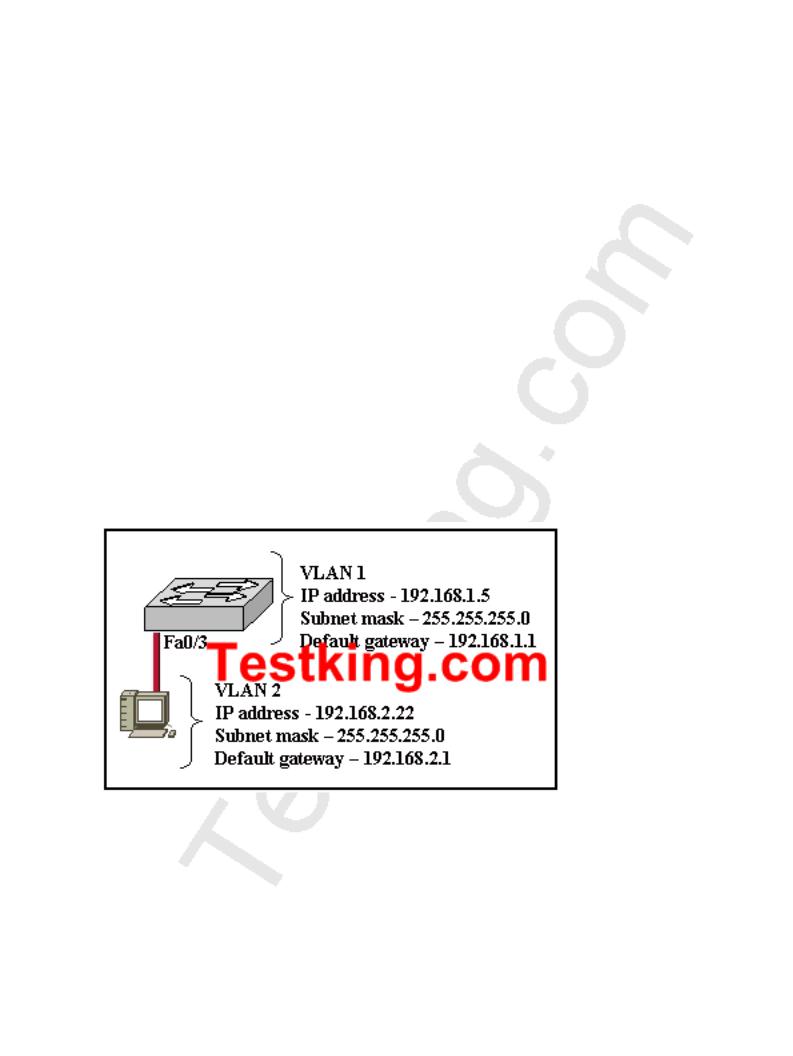
A LAN segment with too many hosts can mean that there are a large number of stations contending for bandwidth. It can also mean an increase in the number of collisions on the segment, which can cause further congestion issues. Broadcast storms are the result of a large number of broadcasts sent over the LAN. Because each station listens to these broadcast messages, congestion can occur quickly. Finally, low bandwidth can simply mean that the LAN can not process all of the LAN traffic that is being sent. This can mean that TCP sessions are retransmitted, which can lead to additional congestion.
Incorrect Answers:
B. This can alleviate congestion, as data can be sent and received at the same time. In addition, collisions are not possible in a full duplex LAN.
D.Multicasting can actually alleviate congestion issues, as single streams of information can reach multiple hosts at the same time, instead of using a series of point to point connections.
E.Segmentation breaks up a large LAN into multiple, smaller LANS. This will mean fewer hosts per broadcast domain.
QUESTION NO: 6
Exhibit:
Refer to the graphic. A TestKing host is connected to switch port Fa0/3 with a crossover cable. The host and switch have been fully configured for IP connectivity as shown. However, the port indicator on switch port Fa0/3 is not on, and the host can not communicate with any other hosts including those connected to VLAN 2 on the same switch. Based on the information given, what is the problem?
Leading the way in IT testing and certification tools, www.testking.com
- 150 -
